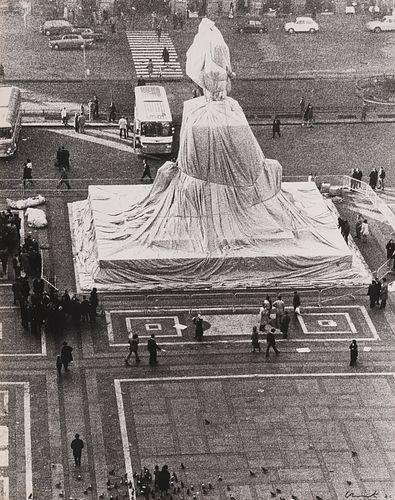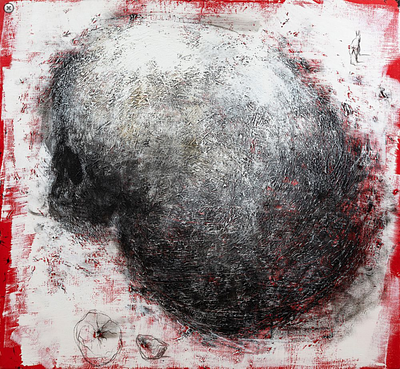CHRISTO (Bulgaria, 1935) "Wrapped Monument Vittorio Emanuele II, 1975. Photograph mounted on cardboard. H.C. copy. Enclosed polygraph certificate.
Lot 9
About Seller
Setdart Auction House
Carrer Aragó 346
Barcelona
Spain
Setdart Subastas was born in 2004 and is currently the first online art auction in Spain with solidity, prestige and reliability guaranteed by our more than 60,000 users. Setdart has a young, dynamic and enterprising team ready to successfully manage the purchase and sale of art works through custom...Read more
Categories
Estimate:
EUR€600 - EUR€800
$638.30 - $851.06
Absentee vs Live bid
Two ways to bid:
- Leave a max absentee bid and the platform will bid on your behalf up to your maximum bid during the live auction.
- Bid live during the auction and your bids will be submitted real-time to the auctioneer.
Bid Increments
| Price | Bid Increment |
|---|---|
| EUR€0 | EUR€10 |
| EUR€200 | EUR€25 |
| EUR€500 | EUR€50 |
| EUR€1,000 | EUR€100 |
| EUR€3,000 | EUR€200 |
| EUR€5,000 | EUR€500 |
| EUR€10,000 | EUR€1,000 |
| EUR€20,000 | EUR€2,000 |
| EUR€50,000 | EUR€5,000 |
About Auction
By Setdart Auction House
Oct 19, 2021
Set Reminder
2021-10-19 08:00:00
2021-10-19 08:00:00
America/New_York
Bidsquare
Bidsquare : CONTEMPORARY ART
https://www.bidsquare.com/auctions/setdart-auction-house/contemporary-art-7701
Setdart Auction House sofia@setdart.com
Setdart Auction House sofia@setdart.com
- Lot Description
CHRISTO (Bulgaria, 1935) "Wrapped Monument Vittorio Emanuele II, 1975. Photograph mounted on cardboard. H.C. copy. Enclosed polygraph certificate. Signed and justified in the lower right corner. Measurements: 76 x 56 cm. The monument to the King of Italy Vittorio Emanuele II, in Piazza del Duomo, and the monument to Leonardo da Vinci, in Piazza della Scala, were wrapped with polypropylene fabric and red polypropylene rope, in the fall of 1970, in Milan, Italy. The fabric had been sewn in advance according to patterns that allowed for wide folds. The two wrapped monuments could be seen from the center of the Galleria, simultaneously, at each end of the large 19th century vaulted pedestrian passageway. Christo together with Jeanne-Claude a renowned artistic couple of the late 20th century, the wrapped objects of are some of the most extreme examples of modern conceptual art. Christo Valdimirov Javacheff, the primary artist and designer of the duo's projects, studied between 1952 and 1956 at the Academy of Fine Arts in Sofia, then spent a year in Prague. In 1957 Christo fled the socialist state and settled in Vienna, from where he traveled to Geneva and finally to Paris, settling in the French capital. His life in Paris was characterized by economic deprivation and social isolation, which was increased by his difficulty in learning the French language. He earned money painting portraits, which he compared to prostitution. Visiting the city's galleries and museums, he was inspired by the work of Joan Miró, Nicholas de Stael, Jackson Pollock, Jean Tinguely and mainly Jean Dubuffet. In January 1958, Christo made his first piece of "wrapped art"; he covered an empty paint jar with a canvas soaked in acrylic. He tied it up and colored it with glue, sand and automobile paint. Christo and Jeanne-Claude met in Paris in November 1958, when he was commissioned to paint a portrait of her mother. Although Jeanne-Claude married another man, she became pregnant by Christo and left her husband after their honeymoon. Despite opposition from Jeanne-Claude's family, the couple married in 1962. By 1959, Christo had changed his approach to wrapped objects. Instead of embellishing the wrapped material with glue and sand, he kept it intact. The following year, he stopped painting altogether and completed his "Inventory" series. In 1961 he tackled what would be his first project with large objects, wrapping barrels in the German port of Cologne. In 1962, as a couple, Christo and Jeanne-Claude tackled their first monumental project, "Rideau de fer" ("Steel Curtain"), as a statement against the Berlin Wall. The work consisted of blocking off Visconti Street over the river with oil barrels. Although Christo was simultaneously holding his first gallery exhibition, it was the Visconti project that made him known in Paris. In 1964 the couple settled in New York, and continued to carry out projects and exhibitions both in the United States and Europe. In 1968 they participated in Documenta 4 in Kassel, and in 1969 they undertook one of their most famous projects, that of wrapping the Little Bay waterfront in Sydney, Australia. Since then, Christo and Jeanne-Claude have undertaken numerous large-scale projects around the world, including "Running fence" and "Wrapped walk".
- Shipping Info
-
In-house shipping available. Please inquire at admin@setdart.com.
-
- Buyer's Premium



 EUR
EUR CAD
CAD AUD
AUD GBP
GBP MXN
MXN HKD
HKD CNY
CNY MYR
MYR SEK
SEK SGD
SGD CHF
CHF THB
THB














